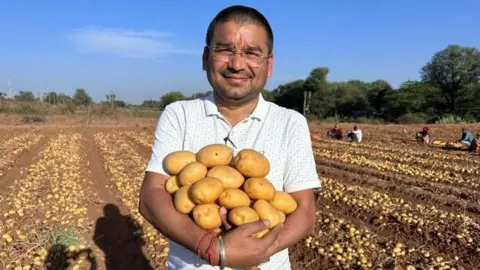**Spud-tacular: How India Became a French Fry Superpower**
India is swiftly establishing itself as a notable force in the global potato market, particularly recognized for its production of quality French fries. The country is currently the second-largest producer of potatoes in the world, fueled by innovation, strategic exports, and a growing domestic market for frozen foods. The agricultural revolution in this sector is exemplified by the story of Jitesh Patel, a farmer from Gujarat, who transitioned his family’s traditional cotton farming to a profitable potato business geared towards the French fry industry.
Jitesh Patel’s journey is emblematic of the overall transformation in Indian agriculture. Coming from a lineage of farmers in Gujarat, Mr. Patel initially faced challenges due to changing climatic conditions and poor returns from traditional crops. Two significant droughts in 2001 and 2002 prompted a significant shift in their farming practices. “We realized that we had to start growing something that does not require a lot of water,” he states. In a bid to adapt to the changing conditions, the Patels began experimenting with different potato varieties, eventually shifting focus to those suitable for the French fry industry after observing the growing demand for processed foods.
The decision to pivot towards specific potato varieties proved advantageous. The establishment of French fry manufacturing facilities in Gujarat, like those owned by Canadian giant McCain Foods and local powerhouse HyFun Foods, heralded a new chapter for local farmers. As Mr. Patel shares, since diversifying into potato cultivation, “there has been no looking back.” Indeed, Gujarat has emerged as India’s capital for French fry production, sending its products globally, and particularly excelling in markets such as Thailand, Indonesia, and the Philippines.
In recent years, the statistics tell a striking story. India’s frozen French fry exports surpassed 20,000 tonnes monthly for the first time in February of the current year, marking a 45% year-on-year increase to a total of 181,773 tonnes within the fiscal year. This impressive growth can be partially attributed to competitive pricing, with Indian fries often available at lower costs than those produced in China.
Analysts like Devendra K have noted that India’s burgeoning status as a French fry superpower stems from its agricultural abundance coupled with cost-effective manufacturing practices. Haresh Karamchandani, the CEO of HyFun Foods, affirms this by highlighting the evolving consumer preferences which favor frozen foods—both in homes and restaurants—as urbanization and disposable incomes rise across the country. HyFun Foods continues to expand its operations, with plans for additional processing plants to meet the increasing local and international demand.
While the potato yield is steadily improving, the entire value chain in India’s frozen food industry requires significant investment in infrastructure, particularly in storage and transportation. The current state of India’s cold storage facilities is inadequate, with only about 10-15% suitable for frozen foods. A notable issue lies in the lack of specialized refrigerated transport, hampering the distribution of products while increasing spoilage risks due to power outages and inefficient logistics.
Despite these challenges, the innovative spirit among farmers like Jitesh Patel shines through. Armed with agricultural education, he and his contemporaries are actively seeking to enhance potato strains and farming methodologies. Innovations such as drip irrigation have significantly improved water management, and practices involving cow manure fertilization ensure soil vitality remains a priority.
Jain Irrigation Systems, a leader in agricultural technology, contributes to these efforts through techniques like tissue culture to genetically enhance potato varieties, addressing common concerns such as sugar content in chips that affects coloring. As the demand for premium French fries grows internationally, Indian farmers are tasked with improving their yield and crop quality, ensuring they stay competitive in an increasingly challenging marketplace.
In conclusion, India’s journey toward becoming a French fry superpower epitomizes agricultural innovation and strategic adaptability. The combination of favorable climatic conditions for potato cultivation in Gujarat, rising consumer demand for processed foods, and an evolving emphasis on quality standards positions India favorably in the global food industry landscape. As farmers like Mr. Patel continue to thrive in this dynamic market, the horizon appears bright for India’s contribution to the global French fry market.











